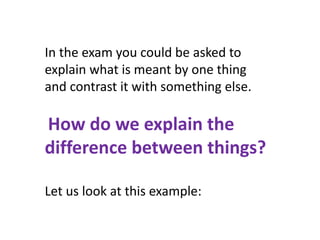
CModule 6 explain the difference
- 1. In the exam you could be asked to explain what is meant by one thing and contrast it with something else. How do we explain the difference between things? Let us look at this example:
- 3. Question Explain the difference between a private and public meeting.
- 4. NOTE 1 Look at the marks allocated. If 8 marks are given, then FOUR differences must be found; if 6 marks, then THREE differences; if 4 marks, then TWO differences.
- 5. NOTE 2 When you are asked to explain, DO NOT put in an example unless you are asked for one as well.
- 6. STEP ONE • Look at the descriptions (or the definitions, if there are) of both types of meetings. • 2. Highlight where the same aspect is considered, but handled differently in the two types of meeting.
- 7. STEP TWO Underline Public meetings may be attended by any member of the public and are usually held to discuss political issues or matters of social, environmental and economic interest. . Notices of these meetings usually appear in newspapers, pamphlets and on posters. As a rule no binding decisions are taken at public meetings. Examples are political rallies, public marches, meetings dealing with anti-animal cruelty matters, religious campaign gatherings, etc
- 8. STEP TWO continued Underline Although non-members are sometimes invited to attend private meetings, these meetings are usually attended by members only. Only members are allowed to vote, and binding decisions may be taken. Notices are sent directly to members. The most common private meetings are general meetings, committee meetings and command (management) meetings. Meetings of sports clubs, cultural societies, school governing bodies, church councils etc. are all examples of private meetings.
- 9. STEP THREE Write down each underlined point for the public meeting as a contrast to the same point under the private meeting.
- 10. How to express the differences Words like “but”, “however” and “yet” indicate that a difference is being pointed out.
- 11. ANSWER • Public meetings may be attended by any member of the public, but private meetings are usually open to members only. [2]
- 12. ANSWER • Notices of public meetings usually appear in the media, but for private meetings notices are sent personally to members. [2]
- 13. ANSWER • Usually no binding decisions are taken at public meetings. However, at private meetings, members may vote and binding decisions can be taken. [2]
